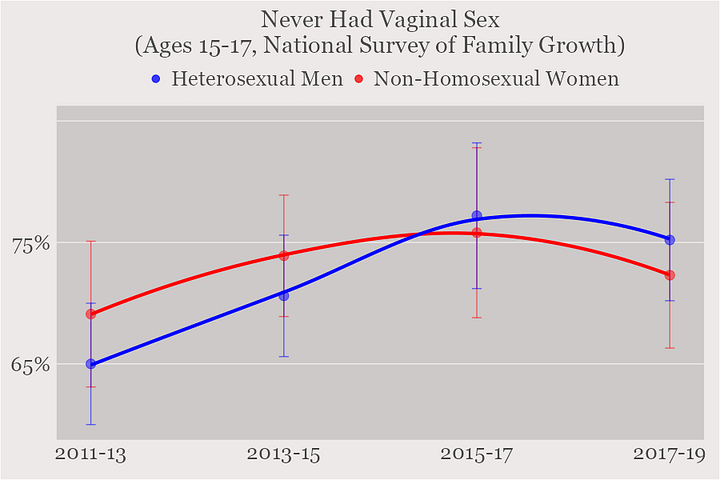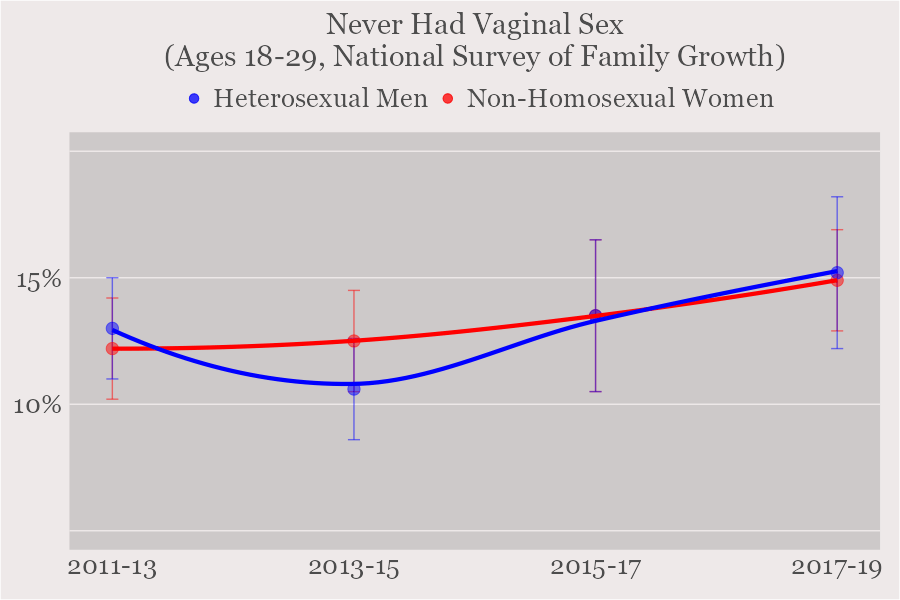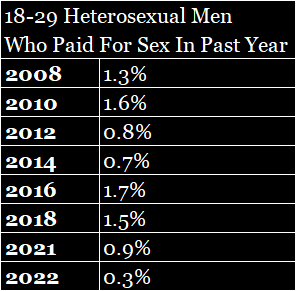For the last five years, this graph has been the focus of intense debate, and has regularly made the rounds on social media:
Videos centred around this graph have raked in millions of views:
It recently went through yet another wave of virality, giving everyone another chance to advance their favoured takes on it:
The problem is, it appears to have been little more than a blip. Despite being arguably the most famous graph in history, very few people have stopped to question its veracity. While I’m not going to challenge the reputation or data collection methodology of the organization behind it, the simple fact is that the sample size is highly limited—especially after being stratified by age and gender.
There are also a few factors causing the percentage to be inflated, even if they aren’t necessarily relevant to the trend. First off you’ll notice the question asks how many female sex partners the respondent has had ‘since turning 18’, meaning partners encountered before 18 may not be captured. I confirmed this as ‘sex partners in the past 5 years’ gives a slightly lower percentage, even though that’s also an imperfect proxy. The journo who put the graph together also left homosexuals in the sample, which due to the question pertaining to heterosexual sex will erroneously classify most of them as virgins, and inflates the percentage by about 2% on average.
Another weird thing I noticed is how the line is completely straight from 2008-16. I wonder if the intermediate data points were dropped to make the trend look more linear.
A closer look at the data
Anyway, despite this 2018 data still being peddled out, there have been two additional surveys conducted since. Wouldn’t you know it, the percentage of ‘virgins’ dropped in both, and was back to square one in 2022. You can see from the wide error bars that these estimates show considerable variability.
This survey is not the only one which collects data on sexual behaviour however. What happens when we instead look at the results of a survey with a much larger sample size? From 2012-2018, the total sample size for heterosexual men answering the sex question was 557.
For another nationally representative survey, the National Survey of Family Growth, it was a whopping 7,056, more than 10x the size.
The resulting graph is rather uninteresting, so you won’t see it popping off on social media any time soon. There is maybe a slight rise from 13% in 2011-13 to 15% in 2017-19. The rates in 2002 and 2006-10 were no lower than in 2011-13 either, though I didn’t include them as a sexual orientation variable isn’t available.
YouGov shows no sign of an continuing sex recession in recent years however. It’s been quite a while since covid restrictions were lifted, so I don’t think the lack of an upward trend can be explained by that anymore. Unfortunately you can’t select both a gender and age group simultaneously, but the trends for men and women overall look quite similar.
What if we restrict the sample to younger cohorts? If there is a trend in virginity it will show up there since of course older people can’t reclaim their v-cards.
Among 15-17 year olds we see a significant rise for males from 65% to 75%, though still no significant gender difference. Among 18-20s it rises from 28-33%, though it’s not significant.


Another survey conducted by the CDC, the Youth Risk Behavior Survey, observed a rise in virginity among male and female high school students (probably amplified by covid in 2021), though we don’t see evidence for a gender disparity in this trend.
This coincides with a reduction in general risk-taking behaviours such as alcohol consumption. Alcohol consumption may facilitate sexual activity, but it’s probably more that they both point to an underlying trend of society becoming more Japanese for lack of a better term.
Criticisms
While this graph has many fans, for many of them it’s not extreme enough. This is why they’ll say the real number is even higher because men are too ashamed to admit to not having had sex even on an anonymous survey. This criticism will intensify in the event that its fans are confronted with more recent data (though it’s hard to see why this would explain sudden shifts or the lack of a substantial rise in the NSFG unless you assume there’s a parallel trend in misreporting).
However, even the Alexander & Fisher1 study that people like to cite as showing that women lie about their body count (it’s a bit more nuanced but that’s another topic) failed to show statistically significant or noticeable differences in reported sexual behaviour or sex partner count in men under either the exposure threat, anonymous, or bogus pipeline (fake lie detector) conditions.
Self-reported sexual partners in the past 6 months also show a clear positive relationship with STD positivity rate among both women and heterosexual men in this Dutch study2:
Another claim is that men are increasingly turning to prostitutes. This isn’t the case judging by the GSS data.
Another is that simply having had sex doesn’t tell you much. Virginity is all or nothing. It’s possible even with stable virginity rates, sexual activity rates are down. Although there is a downward trajectory when it comes to the mean response, the median 18-29 man who’s had sex in the past year still reports having sex around once a week. Obviously this is not a new Tinder hookup every week, but the lion’s share of sexual activity occurs within relationships. The percentage reporting only having had sex once or twice in the past year has remained at a relatively stable 10%.
Finally, some people will point out that in the last GSS survey, about half the responses were registered as ‘inapplicable’. However, this simply means that the module including the sexual behaviour questions wasn’t included on their ballot form and so they never got the question to begin with.
Conclusion
There doesn’t appear to be very strong evidence for a skyrocketing virginity epidemic among young men, or even a male-driven trend whatsoever. Why then is this such a hot topic?
One aspect is likely just that people respond to catastrophic narratives in general. There’s a reason why the media has such a strong negativity bias. Mass killings which have been associated with inceldom have also received much media attention, which may give the impression that it’s a growing threat that may get out of hand; an ‘incel revolution’, if you will.
Another is that there has been something of a growing backlash to feminism and its excesses in recent years, and a feeling that as women have made progress, men have fallen behind and their issues neglected. A good number of feminists themselves have been expressing such concerns. This obviously fits into this broader narrative quite nicely.
It also fits into the common false perception created by dating app dynamics, which I’ve covered before but may do more concisely in a future post.
In terms of why we only hear about male virginity despite no gender disparity, another reason may be because sexual experience is often tied to men’s sense of self-worth while nobody has ever to my knowledge shamed a woman for remaining chaste. Men also have a higher libido and more sexual fantasies, which could make a lack of sexual activity more frustrating. A response to data showing no gender disparity is often that “but it’s a choice for them!”, which I don’t think anyone would seriously dispute.
Nonetheless, there is some evidence that among adolescents at least we’re seeing a rise in virginity, though it’s not clear to what extent if any this will carry over to adulthood. It might mostly just be that people are maturing slower, with the average age of sexual initiation returning to what it was in previous generations (even if not necessarily for the same reasons).
How much more mileage can be squeezed out of this at this point significantly outdated graph I wonder. Each time we hear it’s “probably even higher now!”, yet nobody bothers to look into it any further. I understand why it’s an appealing cope to many men who are struggling though, as it’s comforting to believe one is simply a symptom of a wider social malaise and that everyone else is struggling along with you.
Alexander, M. G., & Fisher, T. D. (2003). Truth and consequences: using the bogus pipeline to examine sex differences in self-reported sexuality. Journal of sex research, 40(1), 27–35. https://doi.org/10.1080/00224490309552164
Kayaert L, Sarink D, Visser M, van Wees DA, Willemstein IJM, Op de Coul ELM, Alexiou ZW, de Vries A, Kusters JMA, van Aar F, Gotz HM, Vanhommerig JW, AI van Sighem, van Benthem BHB (2023). Sexually transmitted diseases in the Netherlands in 2022. National Institute for Public Health and the Environment: Bilthoven.
















Obviously women are most affected